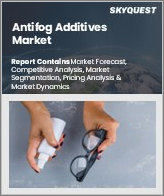
방담 첨가제 세계 시장 규모는 2023년에 3억 9,720만 달러로 평가되었으며, 2024년 4억 1,547만 달러에서 2032년에는 5억 9,538만 달러로 성장하고, 예측 기간(2025-2032년) 동안 CAGR 4.6%로 성장할 전망입니다.
방담 첨가제 시장은 고성능 농업 및 식품 포장 필름에 대한 수요 증가에 크게 영향을 받고 있습니다. 이러한 첨가제는 고분자 농축물을 코팅하고, 표면 에너지를 감소시키고, 물방울 형성을 방지하여 가시성을 향상시킵니다. 또한, 석유 유래 물질에 대한 의존도를 줄이기 위해 바이오 기반의 지속가능한 방담 솔루션으로의 전환도 눈에 띕니다. 방담 특성을 통합한 생분해성 필름의 혁신은 플라스틱 폐기물을 최소화하기 위한 노력을 반영합니다. 아시아태평양, 특히 중국과 인도는 식품 가공 및 농업의 발전에 힘입어 시장 성장을 주도하고 있습니다. 방담 첨가제는 온실 응용 분야에 필수적이며, 빛 투과를 최적화하고 결로를 방지하며 습기 관련 질병을 최소화하여 식물의 건강을 지원합니다.
Global Antifog Additives Market size was valued at USD 397.2 million in 2023 and is poised to grow from USD 415.47 million in 2024 to USD 595.38 million by 2032, growing at a CAGR of 4.6% during the forecast period (2025-2032).
The antifog additives market is significantly influenced by the growing demand for high-performance agricultural and food packaging films. These additives enhance visibility by coating polymer concentrates, reducing surface energy and halting water droplet formation. Additionally, there is a noticeable trend toward bio-based and sustainable antifog solutions aimed at decreasing reliance on petroleum-derived materials. Innovations in biodegradable films with integrated antifog properties reflect a commitment to minimizing plastic waste. The Asia Pacific region, particularly China and India, is leading market growth fueled by advancements in food processing and agriculture. Antifog additives are essential in greenhouse applications, optimizing light transmission and supporting plant health by preventing condensation and minimizing moisture-related diseases.
Top-down and bottom-up approaches were used to estimate and validate the size of the Global Antifog Additives market and to estimate the size of various other dependent submarkets. The research methodology used to estimate the market size includes the following details: The key players in the market were identified through secondary research, and their market shares in the respective regions were determined through primary and secondary research. This entire procedure includes the study of the annual and financial reports of the top market players and extensive interviews for key insights from industry leaders such as CEOs, VPs, directors, and marketing executives. All percentage shares split, and breakdowns were determined using secondary sources and verified through Primary sources. All possible parameters that affect the markets covered in this research study have been accounted for, viewed in extensive detail, verified through primary research, and analyzed to get the final quantitative and qualitative data.
Global Antifog Additives Market Segments Analysis
Global Antifog Additives Market is segmented by Type, Application and region. Based on Type, the market is segmented into Glycerol Esters, Polyglycerol Esters, Sorbitan Esters of Fatty Acids, Ethoxylated Sorbitan Esters, Polyoxyethylene Esters and Others. Based on Application, the market is segmented into Food Packaging Films, Agricultural Films and Others. Based on region, the market is segmented into North America, Europe, Asia Pacific, Latin America and Middle East & Africa.
Driver of the Global Antifog Additives Market
The rising demand for packaged and processed foods significantly propels the antifog additives market. As consumers show a growing preference for ready-to-eat meals, frozen products, and fresh produce wrapped in transparent materials, the need for antifog additives becomes critical in preventing moisture accumulation within packaging. This not only enhances visibility but also extends the products' shelf life. Moreover, the surge in e-commerce grocery services and the proliferation of supermarket chains have intensified the demand for efficient food packaging solutions, further driving the market for antifog additives as manufacturers seek innovative ways to meet consumer expectations.
Restraints in the Global Antifog Additives Market
The global antifog additives market faces significant restraints due to the increasing enforcement of stringent regulations on plastic waste and the use of chemical additives in packaging. Many conventional antifog additives are synthetic, which has sparked concerns regarding their biodegradability and possible environmental repercussions. Legislative initiatives such as the European Union's Single-Use Plastics Directive and China's measures to reduce plastic waste are compelling manufacturers to create environmentally friendly alternatives. However, this shift necessitates greater investments and more lengthy approval procedures, posing challenges for companies in adapting to these evolving regulatory landscapes while maintaining product efficacy.
Market Trends of the Global Antifog Additives Market
The Global Antifog Additives market is witnessing a prominent trend towards the adoption of biodegradable and sustainable additives, driven by increasing environmental awareness and regulatory pressures. Manufacturers are focusing on developing eco-friendly alternatives, including bio-derived surfactants and polymer-based antifog agents, which degrade safely, minimizing environmental impact. This shift supports global initiatives aimed at reducing plastic waste and fostering sustainability across various sectors, particularly in food packaging and agricultural applications. As consumers increasingly favor eco-conscious products, the demand for these innovative, plant-based solutions is expected to surge, shaping the market landscape and encouraging further research and development in sustainable materials.